Abstract
The onset of tachyarrhythmia after the Fontan procedure (total cavopulmonary connection; TCPC) should be considered a medical emergency. Landiolol is an ultra-short-acting β1-selective blocker whose effect on tachyarrhythmia after TCPC is unclear. We evaluated the efficacy and safety of landiolol for tachyarrhythmia after TCPC. Consecutive patients undergoing TCPC were enrolled from January 2007 to December 2011. Of 435 pediatric open heart surgeries, 28 patients underwent TCPC. Of the 28 patients, 13 were treated with landiolol for critical tachyarrhythmia. Excluding three patients who received landiolol during surgery, we investigated the remaining 10 patients and statistical analysis was performed without a 10-year-old patient as outlier. The median age was 4.08 years. The subjects comprised five patients with sinus tachycardia, four with junctional ectopic tachycardia and one with paroxysmal supraventricular tachycardia. The initial dose was 4.7 ± 2.3 μg/kg/min, without a loading dose. Landiolol reduced the heart rate from 151.8 ± 23.2 at the start to 132.9 ± 20.0 at 1 h and 126.1 ± 24.9 at 2 h (P < 0.01 and P < 0.01, respectively), without blood pressure decrease (P = 0.235). Landiolol was effective in treating critical tachyarrhythmia without hemodynamic deterioration. We believe that landiolol is a promising option for postoperative tachyarrhythmia after the Fontan procedure.

Similar content being viewed by others
References
Ono M, Boethig D, Goerler H, Lange M, Westhoff-Bleck M, Breymann T. Clinical outcome of patients 20 years after Fontan operation–effect of fenestration on late morbidity. Eur J Cardiothorac Surg. 2006;30:923–9.
Sakurai T, Kado H, Nakano T, Hinokiyama K, Oda S, Sugiura J, Ushijima T, Ueda Y. The impact of extracardiac conduit-total cavopulmonary connection on apicocaval juxtaposition. Eur J Cardiothorac Surg. 2010;38:439–44.
Balaji S, Daga A, Bradley DJ, Etheridge SP, Law IH, Batra AS, Sanatani S, Singh AK, Gajewski KK, Tsao S, Singh HR, Tisma-Dupanovic S, Tateno S, Takamuro M, Nakajima H, Roos-Hesselink JW, Shah M. An international multicenter study comparing arrhythmia prevalence between the intracardiac lateral tunnel and the extracardiac conduit type of Fontan operations. J Thorac Cardiovasc Surg. 2014;148:576–81.
Balaji S, Gewillig M, Bull C, de Leval MR, Deanfield JE. Arrhythmias after the Fontan procedure. Comparison of total cavopulmonary connection and atriopulmonary connection. Circulation. 1991;84: III162–7.
Stephenson EA, Lu M, Berul CI, Etheridge SP, Idriss SF, Margossian R, Reed JH, Prakash A, Sleeper LA, Vetter VL, Blaufox AD. Pediatric Heart Network Investigators. Arrhythmias in a contemporary fontan cohort: prevalence and clinical associations in a multicenter cross-sectional study. J Am Coll Cardiol. 2010;56:890–6.
Giannakoulas G, Dimopoulos K, Yuksel S, Inuzuka R, Pijuan-Domenech A, Hussain W, Tay EL, Gatzoulis MA, Wong T. Atrial tachyarrhythmias late after Fontan operation are related to increase in mortality and hospitalization. Int J Cardiol. 2012;157:221–6.
Baumgartner H, Bonhoeffer P, De Groot NM, de Haan F, Deanfield JE, Galie N, Gatzoulis MA, Gohlke-Baerwolf C, Kaemmerer H, Kilner P, Meijboom F, Mulder BJ, Oechslin E, Oliver JM, Serraf A, Szatmari A, Thaulow E, Vouhe PR, Walma E. Task force on the management of grown-up congenital heart disease of the European Society of Cardiology, Association for European Paediatric Cardiology, ESC Committee for Practice Guidelines. ESC Guidelines for the management of grown-up congenital heart disease (new version 2010). Eur Heart J. 2010;31:2915–57.
Abrams D, Schilling R. Mechanism and mapping of atrial arrhythmia in the modified Fontan circulation. Heart Rhythm. 2005;2:1138–44.
Atarashi H, Kuruma A, Yashima M, Saitoh H, Ino T, Endoh Y, Hayakawa H. Pharmacokinetics of landiolol hydrochloride, a new ultra-short-acting beta-blocker, in patients with cardiac arrhythmias. Clin Pharmacol Ther. 2000;68:143–50.
Sezai A, Minami K, Nakai T, Hata M, Yoshitake I, Wakui S, Shiono M, Hirayama A. Landiolol hydrochloride for prevention of atrial fibrillation after coronary artery bypass grafting: new evidence from the PASCAL trial. J Thorac Cardiovasc Surg. 2011;141:1478–87.
Sakamoto A, Kitakaze M, Takamoto S, Namiki A, Kasanuki H, Hosoda S, Group J-KS. Landiolol, an ultra-short-acting β 1-blocker, more effectively terminates atrial fibrillation than diltiazem after open heart surgery: prospective, multicenter, randomized, open-label study (JL-KNIGHT study). Circ J. 2012;76:1097–101.
Tokunaga C, Hiramatsu Y, Kanemoto S, Takahashi-Igari M, Abe M, Horigome H, Sakakibara Y. Effects of landiolol hydrochloride on intractable tachyarrhythmia after pediatric cardiac surgery. Ann Thorac Surg. 2013;95:1685–8.
Hasegawa T, Oshima Y, Maruo A, Matsuhisa H, Kadowaki T, Noda R. Landiolol for junctional ectopic tachycardia refractory to amiodarone after pediatric cardiac surgery. Gen Thorac Cardiovasc Surg. 2013;61:350–2.
Wong KK, Potts JE, Etheridge SP, Sanatani S. Medications used to manage supraventricular tachycardia in the infant a North American survey. Pediatr Cardiol. 2006;27:199–203.
Etheridge SP, Craig JE, Compton SJ. Amiodarone is safe and highly effective therapy for supraventricular tachycardia in infants. Am Heart J. 2001;141:105–10.
Burri S, Hug MI, Bauersfeld U. Efficacy and safety of intravenous amiodarone for incessant tachycardias in infants. Eur J Pediatr. 2003;162:880–4.
Saul JP, Scott WA, Brown S, Marantz P, Acevedo V, Etheridge SP, Perry JC, Triedman JK, Burriss SW, Cargo P, Graepel J, Koskelo EK, Wang R, Investigators IAP. Intravenous amiodarone for incessant tachyarrhythmias in children: a randomized, double-blind, antiarrhythmic drug trial. Circulation. 2005;112:3470–7.
Wiest DB, Garner SS, Uber WE, Sade RM. Esmolol for the management of pediatric hypertension after cardiac operations. J Thorac Cardiovasc Surg. 1998;115:890–7.
Tabbutt S, Nicolson SC, Adamson PC, Zhang X, Hoffman ML, Wells W, Backer CL, McGowan FX, Tweddell JS, Bokesch P, Schreiner M. The safety, efficacy, and pharmacokinetics of esmolol for blood pressure control immediately after repair of coarctation of the aorta in infants and children: a multicenter, double-blind, randomized trial. J Thorac Cardiovasc Surg. 2008;136:321–8.
Author information
Authors and Affiliations
Corresponding author
About this article
Cite this article
Miyake, K., Fujita, Y., Yoshizawa, S. et al. Effects of landiolol on refractory tachyarrhythmia after total cavopulmonary connection: a retrospective, observational, cohort study. J Anesth 30, 331–336 (2016). https://doi.org/10.1007/s00540-015-2119-4
Received:
Accepted:
Published:
Issue Date:
DOI: https://doi.org/10.1007/s00540-015-2119-4




